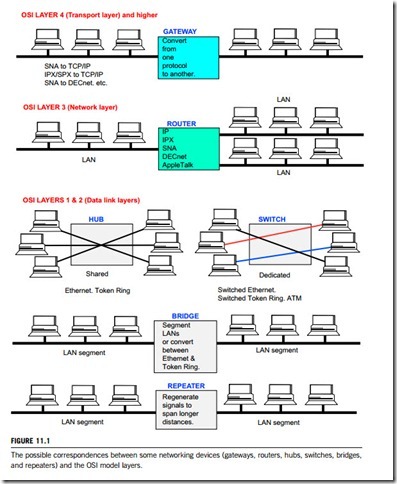Networking devices can also be called networking equipment or networking components. They serve a variety of roles to split, switch, boost, or direct digital data or signals along a network. Products include hubs, switches, routers, bridges, gateways, repeaters, and firewalls.
Hubs provide a central location for attaching wires to network nodes, which can be computers and programmable controllers, etc. Passive hubs do not amplify signals, whereas active hubs serve to extend the wire connection to more network nodes.
A network switch is a small hardware device that connects network nodes together, or allows a large number of nodes to share a limited number of ports.
Routers are protocol-dependent network devices that connect two or more logical subnetworks or network segments.
Bridges, similar to hubs and repeaters, interconnect local or remote networks and operate at the physical and link layers of the open systems interconnection reference model.
A network gateway is an internetworking system capable of joining together two networks that use different base protocols. A network gateway can be implemented completely in software, completely in hardware, or as a combination of both. Depending on the types of protocols they support, network gateways can operate at any level of the open systems interconnection reference model.
Repeaters are IEEE 802.3 network cable segments which use regeneration and retiming to ensure that a signal is transmitted clearly through all subnetworks.
Firewalls are a system or group of systems that, for purposes of security, enforce an access control policy between an enterprise network and the Internet.
The functionality of network devices can be specified in accordance with the OSI reference model. Hubs and repeaters work at the first, physical layer; bridges and switches are thought of as network devices working at the second, data-link layer; routers work at the third, network layer; gateways are the most complex devices with respect to the functionality and work at the fourth layer (transport layer) or the uppermost layers of the OSI reference model. Figure 11.1 is a diagram to illustrate the possible correspondence between these networking devices and the OSI model layers. Hubs and repeaters are network devices without intelligent networking functions, but switches, bridges, routers and gateways have different degrees of network intelligence.
Network devices also use protocols to specify the software attributes of data communications, including the structure of packets. Choices include: asynchronous transfer mode (ATM), controller area network bus (CANbus), control network (ControlNet), DeviceNet, fiber channel, fiber distributed data interface (FDDI), frame relay, integrated services digital network (ISDN), synchro- nous optical network (SONET), token bus and token ring, etc. Ethernet is a popular protocol that uses a bus or star typology. Types include: 10Base-T or twisted pair Ethernet, 10Base-2 or 10/100 Ethernet, 100Base-T or Fast Ethernet, and Gigabit Ethernet. Network equipment is often defined by protocol or port type. Serial port or asynchronous serial interfaces are system-to-system communication interfaces
such as RS232, RS422, and RS485. Selecting network equipment requires an analysis of parameters such as area network type, form factor, memory, performance, and features. There are three types of enterprise network: local area network (LAN), metro area network (MAN), and wide area network (WAN). Form factor choices include chip, board and module. Memory specifications include random access memory (RAM), synchronous dynamic random access memories (SDRAMs), and Flash memory. Data rate, operating temperature, and number of concurrent connections are additional specifications to consider. In terms of features, some products are stackable, rack-mounted, hardened, or suitable for virtual LAN (VLAN). Others have an alarm or indicator, provide IP addressing, and have an integral firewall for security. Network equipment should meet the Restriction of Hazardous Substances (RoHS) directive from the European Union (EU). Full-duplex products can transmit data in both directions.
